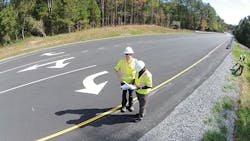“Our Employees Are Our Most Valuable Resource.” Who among us has not heard this mantra?
It is typically a prominent feature on most companies’ websites and highlighted throughout corporate leadership messages and safety programs.
By their nature, construction and infrastructure projects will involve employee stressors, such as:
- Daily commutes to hard-to-reach places, often with appreciable distances.
- Off-site alternate accommodations, resulting in disruptive sleep patterns.
- Poor food choice availability, e.g., food trucks and “greasy spoons.”
- Time away from family and separation anxiety.
- Prolonged work shifts, often on six-days-a-week schedules.
- Limited opportunities for social distancing.
In other words, while trade and craft work is normally well-defined, everything else is complicated. And now the COVID-19 situation adds yet another layer of stress.
Most organizations have structured insurance and benefits plans to provide for employees’ and their families’ medical needs. Workers compensation coverage is statutory and covers an occupational injury or illness, but there is a large gap between post-incident insurance benefits and reality.
While a person may or may not use a company or insurance benefit, they will make choices about their lifestyle, which are subject to a wide range of influences—regrettably not all of them good. The result could be “your most valuable resource” acquiring or prolonging a bad or potentially dangerous habit. Providing health information and education on the job is one avenue to improve the choices and outcomes.
Studies of workforce demographics have clearly mapped the generational shift occurring in the U.S. population as the Baby Boomer generation becomes supplanted by the Millennial generation. Among the challenges facing hiring managers are cultural preferences and language barriers, limited verbal communications, safety training requirements, navigating a complex skill mix and achieving core competencies, and planning for “depth in the backfield” on self-directed work crews. With the guidance of occupational and behavioral health professionals, the concept of employee wellness has come into sharper focus for U.S. business in recent years. Most European countries have long since adopted their version of employee wellness programs, many of which are institutionalized in their labor agreements and statutory provisions.
From another perspective, the Journal of Occupational and Environmental Medicine (JOEM) has a library of mostly supportive research articles devoted to the field of employee wellness. Ironically, one study, titled “Déjà Vu All Over Again,” points to the concept of wellness programs as a cyclical occurrence, showing up on occupational radar screens every 10 years or so.
An informal survey of several large construction industry employers found a well-developed recognition for the value of wellness programs. The consensus among project managers, safety directors, and HR managers was generally uniform in support of providing mechanisms for employees to self-improve their overall health, as well as that of their families, which makes a good deal of sense, even if only to minimize the use of medical benefits.
The U.S. health care system is designed mostly to pay the “back-end” costs for healing a person when something goes wrong. These systems were not structured to pay for educating or incentivizing people to stay well in the first place and avoid the need for costly medical interventions. Some of the larger insurance providers are moving in this direction, but this shift takes time to implement and refine.
A survey of several large infrastructure construction organizations found that the common elements of wellness programs include:
- Suicide prevention, stress management, and mental health; the construction industry is at or near the top of the suicide incidence rates.
- Smoking cessation assistance.
- Obesity and weight control; roughly 42% of the U.S. population is classified as obese.
- Cardio-fitness, heart disease, and hypertension screening.
- Sleep apnea and chronic fatigue management.
- Hydration, heat stress avoidance.
- Environmental and seasonal issues.
- Diabetes screening and treatment referral.
- Cost-reduced or subsidized family membership in gyms and fitness centers.
- Dietary choices and healthy food awareness; e.g., incentivizing healthy choices from food trucks and vendors; reducing availability and consumption of carbonated sugary drinks; promoting healthy snack alternatives.
- An on-site nurse providing occupational and non-occupational services.
- Use of telemedicine and video consultations.
- Preemployment physicals expanded to include health risk factors.
- Opioid, substance, and alcohol abuse counseling and rehabilitation.
- Post-injury early return to work programs.
- Nurse case managers engaged early in the event of an injury.
- Employee interventions: employees are encouraged to speak up if they notice warning behaviors or negative indicators among coworkers.
There would seem to be something wrong with this list. Very few of these are “job-related” issues. Yet they directly impact your most valuable resource, and while wellness program benefits are generally intangible, over time benefits can include:
- Improved attendance; decreased absenteeism and tardiness rates.
- Improved safety performance record.
- Faster healing and recovery in the event of an injury; likely including a COVID-19 infection.
- Less dependence on medications, rehab therapy, and services.
- Earlier return to full duty employment following an injury.
- Less impact on personal medical or disability insurance.
- Less disruption to family and home life.
Clearly, there’s a lot at stake
Large insurance programs have begun to figure out that a healthier employee is generally a safer employee, and many organizations have a well-developed occupational safety and health program already implanted in their company culture.
John Flannigan, Director of Human Resources with paving contractor Branscome Inc., shares this appraisal of his organization’s achievement: “Our employee wellness program has been in effect for several years. One of the components of our program includes an employee receiving preferred rates on their medical insurance premiums when they complete an annual wellness exam with their personal care provider (PCP). If an employee has a spouse on the plan, they also need to have an annual wellness exam completed by their PCP for the preferred insurance premium rate. Our goal is to achieve a healthy workforce. By having this relationship with a PCP and conducting an annual exam, an illness can be identified at an early stage. This allows treatment that will hopefully resolve an issue early and keep a person working or get them back on the job as soon as possible. This feature also helps to keep our insurance costs lower, which impacts everyone on the medical plan. Our wellness plan also includes a service called Teladoc. This feature has been especially helpful during the COVID-19 onset. An employee can be counseled or treated for routine non-emergency issues by a state-certified doctor by phone or video conference. This process is safe because it avoids exposure to other sick patients and saves time by not having to wait for an appointment. Medications can be prescribed and picked up at a local pharmacy within the hour. We are very pleased with the outcomes.”
Bob Jarrett, Executive Director of Employee Health Services for Fluor, concurs, describing his company’s efforts as “[recognizing] the critical values not only of occupational safety and health, but also the fact that employees are individuals, many with families and loved ones who depend on them. Our employee wellness program is oriented toward the well-being of the person, both on and off the job. We clearly want our people to have the right information for risk avoidance at work, which we provide through a number of safety vehicles, such as technical training and qualifications. We also seek to enable each employee with education and resources oriented toward helping them make informed choices in their daily living activities. The term ‘wellness’ covers a lot of ground. It is thoroughly understood by the health care community, and we recognize these professionals have a lot more to offer our people than injury care. ... We understand that a healthy employee generally translates to a safer and more well-rounded person. Attendance, productivity, quality of work, and other tangential benefits also accrue. And if there is an injury or illness, recovery and return to work is generally faster, with less dependence on medications and rehabilitation. We view employee wellness as an essential part of our overall safety and health program.”
Finding supportive information
The Society of Human Resource Management (SHRM) published a detailed “How-To Guide” on its website describing the major elements of a successful wellness program, showing the trend of wellness becoming “accepted practice” within the industry.
According to Rob Stiles Sr., Vice President of Risk Services for Rutherfoord/Marsh & McLennan Insurance in Richmond, Virginia, “The traditional safety paradigm is shifting to now include a component for employee wellness. Our clients invest a lot of time, energy, and resources to shape their organizations’ safety values for the traditional occupational reasons, such as risk identification and avoidance, and regulatory compliance. This new emerging model promotes safety and personal health values being extended beyond the workplace, ideally reaching the entire family. The reality is, an organization’s values in employee safety and personal health through a wellness program can have a beneficial impact on managing risks in a work environment. A healthy and fit employee will generally exhibit a strong safety awareness and attitude. This typically leads to good outcomes both at work and at home.”
Considering the amount of time and effort devoted to recruitment, screening, hiring, orientation, safety training, quality assurance, and skills development, establishing a wellness program is a complementary and logical step. After all, and notably in the face of COVID-19, all employees are essential—otherwise they would not be there.
One may predict that when this crisis’s heroes are determined, those in the construction trades will stand among health care workers and first responders. The mantra of being essential is, by definition, part of the construction industry. Construction workers are accustomed to dealing with challenging conditions—you could say it is part of their DNA. Basic and intermediate industrial hygiene practices have long been integral parts of most ESH programs, for example in PPE and respiratory protection, silica dust controls, confined-space work, welding and hot work, and air quality and filtration, among others.
A typical construction project is sensitive to a wide array of jobsite conditions. Now, COVID-19 precautions include the relatively simple practices of handwashing and use of sanitizer, separation of space, using respiratory protection, and cleaning tools and shared surfaces as part of the daily work routine. A lot of this was part of the daily routine to start with, and the trades seem to be taking the new precautions in stride. As of this writing, the curve is flattening gradually, allowing shuttered projects to incrementally resume with precautions in place, and employee wellness programs will play a crucial role in this process. If an employee is in good general health to begin with, their natural defense mechanisms are more robust—affording a better chance of avoiding disease in the first place, and of recovering if they do contract it. The comprehensive application of an employee wellness program points to a smarter, better defended, and more resilient employee population. That’s a good recovery outcome any way you look at it.



